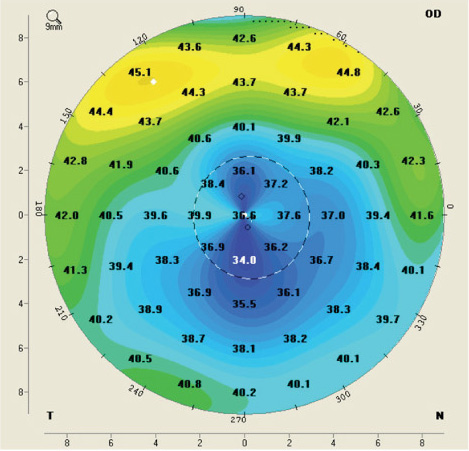Korean J Ophthalmol.
2009 Mar;23(1):1-5. 10.3341/kjo.2009.23.1.1.
The Comparison of Central and Mean True-Net Power (Pentacam) in Calculating IOL-Power After Refractive Surgery
- Affiliations
-
- 1The Institute of Vision Research, Department of Ophthalmology, Yonsei University College of Medicine, Seoul, Korea. tikim@ yumc.yonsei.ac.kr
- 2Siloam Eye Hospital, Seoul, Korea.
- 3Department of Ophthalmology, Ulsan University Hospital, University of Ulsan College of Medicine, Ulsan, Korea.
- 4HanGil Eye Hospital & Laser Center, Incheon, Korea.
- KMID: 1115643
- DOI: http://doi.org/10.3341/kjo.2009.23.1.1
Abstract
-
PURPOSE: To compare the accuracy of central true net corneal power (cTNP) and mean true net corneal power (mTNP) of the Pentacam system to give a keratometry (K) reading for calculating IOL (intraocular lens) power in eyes following refractive surgery.
METHODS
Refraction, an automated K-reading (Km), cTNP and mTNP were measured for 15 eyes that required cataract surgery and had previously undergone refractive surgery. The difference between postoperative manifest refraction values and target refraction values calculated with the SRK/T formula using cTNP were compared with the one using mTNP.
RESULTS
The mean deviation from the desired post-cataract refractive outcome was 0.60 diopter (D) +/-0.47 (standard deviation) using cTNP; 0.75+/-0.54 using mTNP (p=0.386). The actual refraction was within +/-0.50D of the intended refraction for 60% (cTNP) and 33.3% (mTNP) of eyes, and within +/-1.00D for 93% (cTNP) and 66.7% (mTNP) of eyes.
CONCLUSIONS
Although not statistically significant, the cTNP showed better accuracy than mTNP to give a keratometry (K) reading for post-refractive surgery eyes requiring cataract surgery.
MeSH Terms
Figure
Cited by 1 articles
-
Comparison of Intraocular Lens Power Calculation Methods Following Myopic Laser Refractive Surgery: New Options Using a Rotating Scheimpflug Camera
Kyuyeon Cho, Dong Hui Lim, Chan-min Yang, Eui-Sang Chung, Tae-Young Chung
Korean J Ophthalmol. 2018;32(6):497-505. doi: 10.3341/kjo.2018.0008.
Reference
-
1. Gimbel H, Sun R, Kaye GB. Refractive error in cataract surgery after previous refractive surgery. J Cataract Refract Surg. 2000. 26:142–144.2. Holladay JT. Intraocular lens power calculations for the refractive surgeon. Oper Tech Cataract Refract Surg. 1996. 1:105–117.3. Ishikawa T, Hirano A, Inoue J, et al. Trial for new intraocular lens power calculation following phototherapeutic keratectomy. Jpn J Ophthalmol. 2000. 44:400–406.4. Aramberri J. Intraocular lens power calculation after corneal refractive surgery: double-K method. J Cataract Refract Surg. 2003. 29:2063–2068.5. Maeda N, Klyce SD, Smolek MK, MacDonald MB. Disparity between keratometry-style readings and corneal power within the pupil after refractive surgery for myopia. Cornea. 1997. 16:517–524.6. Kalski RS, Danjoux JP, Fraenkel GE, et al. Intraocular lens power calculation for cataract surgery after photorefractive keratectomy for high myopia. J Refract Surg. 1997. 13:362–366.7. Seitz B, Langenbucher A. Intraocular lens power calculation in eyes after corneal refractive surgery. J Refract Surg. 2000. 16:349–361.8. Seitz B, Langenbucher A. Intraocular lens calculations status after corneal refractive surgery. Curr Opin Ophthalmol. 2000. 11:35–46.9. Gimbel HV, Sun R, Furlong MT, et al. Accuracy and predictability of intraocular lens power calculation after photorefractive keratectomy. J Cataract Refract Surg. 2000. 26:1147–1151.10. Hugger P, Kohnen T, La Rosa FA, et al. Comparison of changes in manifest refraction and corneal power after photorefractive keratectomy. Am J Ophthalmol. 2000. 129:68–75.11. Gimbel HV, Sun R. Accuracy and predictability of intraocular lens power calculation after laser in situ keratomileusis. J Cataract Refract Surg. 2001. 27:571–576.12. Hamilton DR, Hardten DR. Cataract surgery in patients with prior refractive surgery. Curr Opin Ophthalmol. 2003. 14:44–53.13. Holladay JT. Consultations in refractive surgery. Refract Corneal Surg. 1989. 5:203.14. Feiz V, Mannis MJ, Garcia-Ferrer F, et al. Intraocular lens power calculation after laser in situ keratomileusis for myopia and hyperopia: a standardized approach. Cornea. 2001. 20:792–797.15. Walter KA, Gagnon MR, Hoopes PC Jr, Dickinson PJ. Accurate intraocular lens power calculation after myopic laser in situ keratomileusis, bypassing corneal power. J Cataract Refract Surg. 2006. 32:425–429.16. Kang JH, Park JI, Lee KH. A New Method for Measuring Corneal Refractive Power after Refractive Surgery. J Korean Ophthalmol Soc. 2005. 46:859–864.17. Zeh WG, Koch DD. Comparison of contact lens overrefraction and standard keratometry for measuring corneal curvature in eyes with lenticular opacity. J Cataract Refract Surg. 1999. 25:898–903.18. Grzybowski DM, Roberts CJ, Mahmoud AM, Chang JS Jr. Model for nonectatic increase in posterior corneal elevation after ablative procedures. J Cataract Refract Surg. 2005. 31:72–81.19. Twa MD, Roberts C, Mahmoud AM, Chang JS Jr. Response of the posterior corneal surface to laser in situ keratomileusis for myopia. J Cataract Refract Surg. 2005. 31:61–71.20. Koch DD, Liu JF, Hyde LL, et al. Refractive complications of cataract surgery after radial keratotomy. Am J Ophthalmol. 1989. 108:676–682.21. Seitz B, Langenbucher A, Nguyen NX, et al. Unerestimation of intraocular lens power for cataract surgery after myopic photorefractive keratectomy. Ophthalmology. 1999. 106:693–702.22. Masket S, Masket SE. Simple regression formula for intraocular lens power adjustment in eyes requiring cataract surgery after excimer laser photoablation. J Cataract Refract Surg. 2006. 32:430–434.23. Wang Z, Chen J, Yang B. Posterior corneal surface topographic changes after laser in situ keratomileusis are related to residual corneal bed thickness. Ophthalmology. 1999. 106:406–409.24. Seitz B, Torres F, Langenbucher A, et al. Posterior corneal curvature changes after myopic laser in situ keratomileusis. Ophthalmology. 2001. 108:666–672.25. Gobbi PG, Carones F, Brancato R. Keratometric index, videokeratography, and refractive surgery. J Cataract Refract Surg. 1998. 24:202–211.26. Hoffer KJ. The Hoffer Q formula: a comparison of theoretic and regression formulas. J Cataract Refract Surg. 1993. 19:700–712.
- Full Text Links
- Actions
-
Cited
- CITED
-
- Close
- Share
- Similar articles
-
- Comparison of Four Systems of IOL Calculation after Keratorefractive Surgery in Eyes Requiring Cataract Surgery
- Comparison of Intraocular Lens Power Calculation Methods Following Myopic Laser Refractive Surgery: New Options Using a Rotating Scheimpflug Camera
- Comparative Analysis of Corneal Refractive Power Measured with AL-Scan(R), Autokeratometer, and Pentacam(R)
- Effect of Vitrectomy on IOL Calculation for Cataract Surgery : Study of Vitrectomized Eyes
- Formula Comparison for Intraocular Lens Power Calculation Using IOL Master and Ultrasound for the ZCB00 IOL



